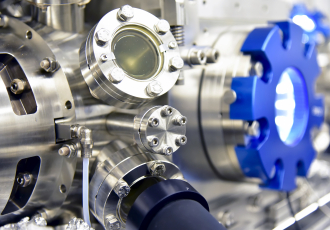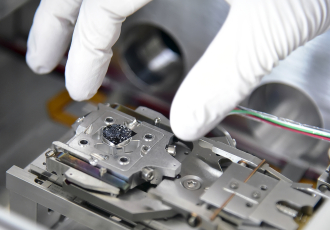29. srpna 2024
The CEITEC Nano Laboratories, as a key part of the CzechNanoLab national research infrastructure, have held the position of a world-class scientific research facility for years thanks to their first-class equipment. This is largely due to the successful modernisation of instrumentation and laboratory equipment carried out between 2017 and 2021, supported by the European Union from the European Regional Development Fund through the Operational Programme Research, Development and Education. Since the beginning, the research team has been led by Michal Urbánek, Head of CEITEC Nano.
“The CEITEC Nano+ project was aimed at modernising the CEITEC Nano research infrastructure at Brno University of Technology in cooperation with Masaryk University, with the aim of strengthening the performance, relevance and excellence of research at our science centre, mainly in the field of nanotechnology and nanoscience. Thanks to this project, the science centre was able to integrate more deeply into international scientific structures and strengthen its position as a top European research centre,” said Michal Urbánek, adding that the project was approved for a total of about 146 million Czech crowns, of which 124 million was covered by subsidies from the European Regional Development Fund (ERDF).
Researchers from more than 20 countries
What makes CEITEC Nano laboratories unique? “It's not so much a particular instrument as the fact that we have a large number of high-end instruments together forming a coherent technological and analytical line so that a scientist can do his research in one place without the need to travel anywhere,” Urbánek outlines. The laboratory costs 50 million crowns a year to run, and the investment in instruments is around 800 million. “We receive twenty-seven million crowns every year from the Czech Ministry of Education, Youth and Sports, and other resources come from our own projects and fees from the centre’s users. The users are mostly students of all levels of study and researchers of various backgrounds. Most of our visitors come from CEITEC BUT, but there are also people interested in the services at other faculties of Brno University of Technology, CEITEC Masaryk University and the Faculty of Science of Masaryk University. Some users also come from abroad, most of them from Austria, Poland, Hungary, and Germany, but we also have regular visitors from England. In total, researchers of more than twenty nationalities have used the services of our centre,” says Urbánek.
A top research facility
The laboratory itself is divided into four parts: the nanofabrication laboratory, where nanostructures and nanoparticles are produced, the nanocharacterisation laboratory, where the samples produced are examined, the structural analysis laboratory for the investigation of the structure of materials, and the computed tomography laboratory, with which 3D mapping of materials and components can be performed using X-rays. However, maintaining a position as a top research facility is no easy matter, and the research team is very aware of this. This was one of the main reasons why we decided to go one step further and launch the CechNanoLab+ modernisation project.
“Last year, we submitted an application in the OP JAK Research Infrastructure I. grant call organised by the Czech Ministry of Education, Youth and Sports. Our modernisation project succeeded with an astonishing score of seventy-eight points out of eighty, making it the most successful project in this call. The project was supported for funding without budget cuts and received a total of CZK 361 million for the modernisation and innovation of existing equipment,” said Michal Urbánek, who is the coordinator of the entire CzechNanoLab infrastructure.

From nanotechnology to semiconductor chips
CzechNanoLab is a research infrastructure for nanoscience and nanotechnology research. It primarily serves scientists whose research ambitions are to push the boundaries of knowledge in various fields, from physics to nanoelectronics to neuroscience. “The uniqueness of the infrastructure lies in the link between basic academic research and industrial applications, and most importantly, it provides a space to implement, experiment and get feedback on their ideas. This makes the laboratories an ideal breeding ground for further research projects,” explains Michal Urbánek.
In addition to nanoscience and nanotechnology research, the laboratories are also an important part of the national innovation ecosystem in the priority area of semiconductor chips. This means that it is the only facility of its kind in the Czech Republic that can provide access to the instrumentation and know-how needed for research and development in this area. “The development of scientific equipment is constantly moving forward, and many of our existing instruments are technically or morally obsolete. That is why we want to use the CzechNanoLab+ project to modernise our equipment to the highest technological level and thus remain among the best research infrastructures. In addition, it will allow us to increase the range of services, thanks to the introduction of new promising technologies that we have not had so far,” Urbánek outlined the future perspective.
The modernisation project started on 1 January this year and is scheduled to last for three years. Two thirds of the total amount of CZK 361 million will go to CEITEC Nano in Brno, while the remaining third will go to the Prague Laboratory of Nanostructures and Nanomaterials at the Institute of Physics of the Czech Academy of Sciences, the other node of the CzechNanoLab research infrastructure.


 Sdílet
Sdílet




